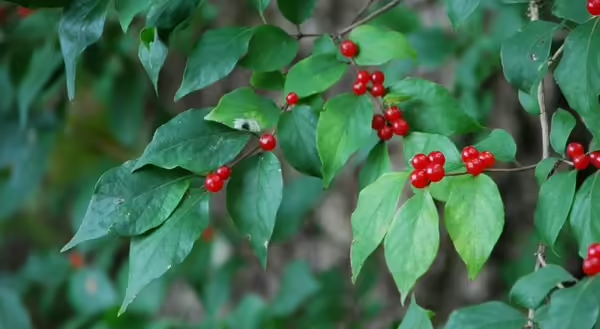
Effective communication in invasive species management relies on consistent and accurate terminology. Confusion is a problem when terms are not clearly defined. Agreeing on terminology helps to clearly communicate so that everyone can understand what invasive species are and why there is concern about them.
Native and Non-native
The first words that must be clearly defined in a conversation about invasive species are native and non-native.
- A good definition for native is a species that occurs naturally in a specified geographic area.
- At the same time, a non-native species does not occur naturally in a specific geographic location.
For example, red maple (Acer rubrum) and Norway maple are found in the United States. The red maple's native range is broad across the eastern half of the United States, but the Norway maple's range is in Europe. By these definitions, red maple is native to North America and non-native to Europe.
Native and non-native can also be defined in a certain period, but this can be difficult to determine precisely with the movement of plants, animals, and changing landscapes.
Introduced
An introduced species is one that humans have relocated to a new area, intentionally or accidentally, making it non-native. Introduced species are not always harmful; they can be advantageous. For example, many introduced species enhance the visual appeal of residential landscapes, while various crop and livestock species, such as wheat, cattle, and European honeybees, offer nutritional value.
Like the terms native and non-native, categorizing a species as introduced relies on a particular geographical area. It is more precise to clarify that daffodils ( Narcissus pseudonarcissu) are introduced to the United States rather than just using the general label "introduced."
Established
Many introduced species do not expand into new areas. For example, numerous non-native ornamental plants in people's gardens remain in those spaces. However, some species escape from cultivation or containment and independently form self-sustaining populations. These populations would be termed "established."
It is important to note that species native to a specific location are also technically considered established. However, the term "established" is useful as it helps differentiate between non-native species that rely solely on human care (like crop species) and those that can survive, reproduce, and spread to new areas independently.
Invasive
Three criteria must be satisfied to categorize a species as invasive. The species should be non-native, introduced intentionally or unintentionally, and cause harm to the economy, environment, or humans.
An example of an invasive plant in Illinois is the Amur Bush Honeysuckle (Lonicera maacki). Amur Bush Honeysuckle is widespread across the Midwest, altering ecosystems and impeding the growth of native plant species.
Nuisance
Under certain circumstances, certain native species can pose environmental or economic challenges. These species can be commonly labeled as invasive or native invasive in these instances. However, these terms must be more accurate as these species are neither non-native nor introduced. The appropriate term for such situations is "nuisance."
While all invasive species display nuisance characteristics, referring to them as invasive is preferred to emphasize their non-native and introduced status.
For example, the trumpet creeper vine (Campsis radicans), native to a large part of the United States, can spread rapidly and be challenging to control. In scenarios like garden maintenance or managing small natural areas, the vigorous growth of any trumpet creeper in these locations can be considered a nuisance. While all invasive species display nuisance characteristics, referring to them as invasive is preferred to emphasize their non-native and introduced status.
Range Change
The term "range change" is the final concept we discuss. A range change happens when a species' current range expands, shrinks, or shifts. This phenomenon can occur naturally or with human involvement for native and non-native species. Hence, if a native species naturally expands its range without human intervention, it should not be labeled as non-native, introduced, or invasive. Instead, it is more accurate to describe it as a native species undergoing a range change.
Many North American tree species native to the United States are undergoing range changes due to altered precipitation patterns linked to climate change (Fei et al., 2017). Humans are not responsible for intentionally or unintentionally relocating these species to new areas.
Avoiding Misleading Terminology in Describing Species
The term "native invasive" is inaccurate as native species cannot be invasive. Instead, when referring to native species causing management concerns, they should be called nuisances.
- The term "invasive exotic" is confusing as all invasive species are non-native.
- "Invasive weed" is misleading as "weed" is a subjective term. It can cause confusion by not specifying whether the plant is unwanted, native, non-native, or invasive. Using "invasive weed" may lead people to believe all weeds are invasive.
- Terms like "alien," "foreign," and "nonindigenous" should be avoided as they are often linked to human migration. "Non-native" is a more suitable term for describing species introduced to new environments.
Invasive species present significant environmental, economic, and direct threats to humans. For clarity, using standardized definitions for terminology is necessary. Knowing these key terms can help get conversations started so that changes can be made.
Definitions can be found
Iannone, B. V., Carnevale, S., Main, M. B., Hill, J. E., McConnell, J. B., Johnson, S. A., Enloe, S. F., Andreu, M., Bell, E. C., Cuda, J. P., & Baker, S. M. (2020). Invasive Species Terminology: Standardizing for Stakeholder Education. The Journal of Extension, 58(3), Article 27.